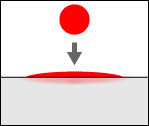Types of Ink
There are two types of ink for inkjet printers: pigment ink and dye ink.
The type of ink that can be used vary by printer, and there are models that adopt pigment ink and those that adopt dye ink among Canon printers as well.
Pigment Ink and Dye Ink
-
Pigment Ink
Pigment is a particulate water-insoluble coloring material; ink particles remain on the paper surface. Because of the water insolubility, blurring can be reduced even when wet. In addition, colors are stable from immediately after printing and relatively insensitive to environmental factors; storage stability of the printed material is excellent. However, when printed on glossy paper, careful handling is required since the ink may come off if scratched.
-
Dye Ink
Dye is a water-soluble coloring material; ink seeps into the paper together with the water contained in the ink. The ink leaves no roughness on the paper, and the print result will be more vivid than that of pigment ink. However, depending on the paper to be used, when the paper gets wet, the ink that has seeped into the paper may be mixed with the water, resulting in blurring.
Pigment Ink Dye Ink 

Characteristics of Pigment Ink and Dye Ink
| Pigment Ink | Dye Ink | |
|---|---|---|
| Advantage |
|
|
| Disadvantage |
|
|



